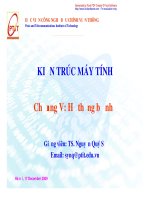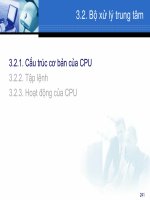Kiến trúc máy tính - Chương 8: Hệ thống bộ nhớ pptx
Bạn đang xem bản rút gọn của tài liệu. Xem và tải ngay bản đầy đủ của tài liệu tại đây (472.4 KB, 55 trang )
Chương 8
Hệ thống bộ nhớ
Khoa KTMT Thiều Xuân Khánh 1
Nội dung
1. Các cấp bộ nhớ (Memory Hierarchy)
2. Bộ nhớ cache (Cache Memory)
3. Bộ nhớ trong (Main Memory)
4. Bộ nhớ ảo (Virtual Memory)
Khoa KTMT Thiều Xuân Khánh 2
Các cấp bộ nhớ (Memory Hierarchy)
Registers
–
In CPU
Internal or Main memory
–
May include one or more levels of cache
–
“RAM”
External memory
–
Backing store
Khoa KTMT Thiều Xuân Khánh 3
Memory Hierarchy - Diagram
Performance
Access time
–
Time between presenting the address and getting the valid data
Memory Cycle time
–
Time may be required for the memory to “recover” before next access
–
Cycle time is access + recovery
Transfer Rate
–
Rate at which data can be moved
Khoa KTMT Thiều Xuân Khánh 6
Physical Types
Semiconductor
–
RAM
Magnetic
–
Disk & Tape
Optical
–
CD & DVD
Others
–
Bubble
–
Hologram
Physical Characteristics
Decay
Volatility
Erasable
Power consumption
Organisation
Physical arrangement of bits into words
Not always obvious
e.g. interleaved
The Bottom Line
How much?
–
Capacity
How fast?
–
Time is money
How expensive?
Hierarchy List
Registers
L1 Cache
L2 Cache
Main memory
Disk cache
Disk
Optical
Tape
So you want fast?
It is possible to build a computer which uses only static RAM
(see later)
This would be very fast
This would need no cache
–
How can you cache cache?
This would cost a very large amount
Locality of Reference
During the course of the execution of a program, memory
references tend to cluster
e.g. loops
2. Cache
Tổ ch
Khoa KTMT Thiều Xuân Khánh 14
Cache
Small amount of fast memory
Sits between normal main memory and CPU
May be located on CPU chip or module
Cache/Main Memory Structure
Cache operation – overview
CPU requests contents of memory location
Check cache for this data
If present, get from cache (fast)
If not present, read required block from main memory to cache
Then deliver from cache to CPU
Cache includes tags to identify which block of main memory
is in each cache slot
Cache Read Operation - Flowchart
Cache Design
Size
Mapping Function
Replacement Algorithm
Write Policy
Block Size
Number of Caches
Size does matter
Cost
–
More cache is expensive
Speed
–
More cache is faster (up to a point)
–
Checking cache for data takes time
Typical Cache Organization
Comparison of Cache Sizes
Processor Type
Year of
Introduction
L1 cachea
L2 cache L3 cache
IBM 360/85 Mainframe 1968 16 to 32 KB — —
PDP-11/70 Minicomputer 1975 1 KB — —
VAX 11/780 Minicomputer 1978 16 KB — —
IBM 3033 Mainframe 1978 64 KB — —
IBM 3090 Mainframe 1985 128 to 256 KB — —
Intel 80486 PC 1989 8 KB — —
Pentium PC 1993 8 KB/8 KB 256 to 512 KB —
PowerPC 601 PC 1993 32 KB — —
PowerPC 620 PC 1996 32 KB/32 KB — —
PowerPC G4 PC/server 1999 32 KB/32 KB 256 KB to 1 MB 2 MB
IBM S/390 G4 Mainframe 1997 32 KB 256 KB 2 MB
IBM S/390 G6 Mainframe 1999 256 KB 8 MB —
Pentium 4 PC/server 2000 8 KB/8 KB 256 KB —
IBM SP
High-end server/
supercomputer
2000 64 KB/32 KB 8 MB —
CRAY MTAb
Supercomputer 2000 8 KB 2 MB —
Itanium PC/server 2001 16 KB/16 KB 96 KB 4 MB
SGI Origin 2001 High-end server 2001 32 KB/32 KB 4 MB —
Itanium 2 PC/server 2002 32 KB 256 KB 6 MB
IBM POWER5 High-end server 2003 64 KB 1.9 MB 36 MB
CRAY XD-1 Supercomputer 2004 64 KB/64 KB 1MB —
Mapping Function
Cache of 64kByte
Cache block of 4 bytes
–
i.e. cache is 16k (2
14
) lines of 4 bytes
16MBytes main memory
24 bit address
–
(2
24
=16M)
Direct Mapping
Each block of main memory maps to only one cache line
–
i.e. if a block is in cache, it must be in one specific place
Address is in two parts
Least Significant w bits identify unique word
Most Significant s bits specify one memory block
The MSBs are split into a cache line field r and a tag of s-r
(most significant)
Direct Mapping
Address Structure
Tag s-r Line or Slot r Word w
8
14 2
24 bit address
2 bit word identifier (4 byte block)
22 bit block identifier
–
8 bit tag (=22-14)
–
14 bit slot or line
No two blocks in the same line have the same Tag field
Check contents of cache by finding line and checking Tag









